The guinea pig is a herbivore, and needs to eat continually to ensure sufficient throughput of nutrition within its gut (Figure 1). It is therefore important to understand the principles of guinea pig nutrition, and to be able to recognize conditions that may be diet related, and those that can be corrected in full or in part by dietary modification. Very few conditions that are seen in practice in guinea pigs are actually infectious; the majority are related in some way to husbandry and diet. As a veterinary nurse, being able to offer sound nutritional advice to guinea pigs’ owners will go a long way in preventing many problems occurring. When taking a clinical history from an owner obtaining full details of the diet is invaluable.
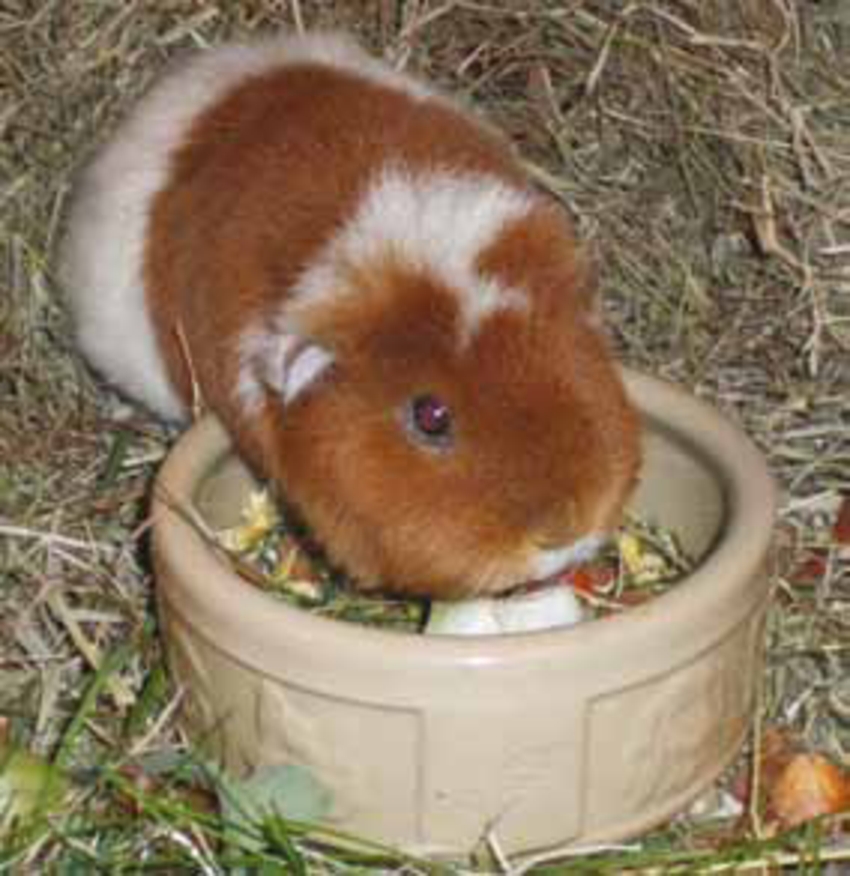
Guinea pigs are hystricomorph rodents, meaning that they have a long gestation period and the young are born at an advanced stage of development, fully-furred and with their eyes open (Figure 2). They start eating solid food from 2 days of age, and babies orphaned at 3 days old have been known to survive without any supplementation (personal experience). It is important to introduce a correct and varied diet at this early age, and start good eating habits early.
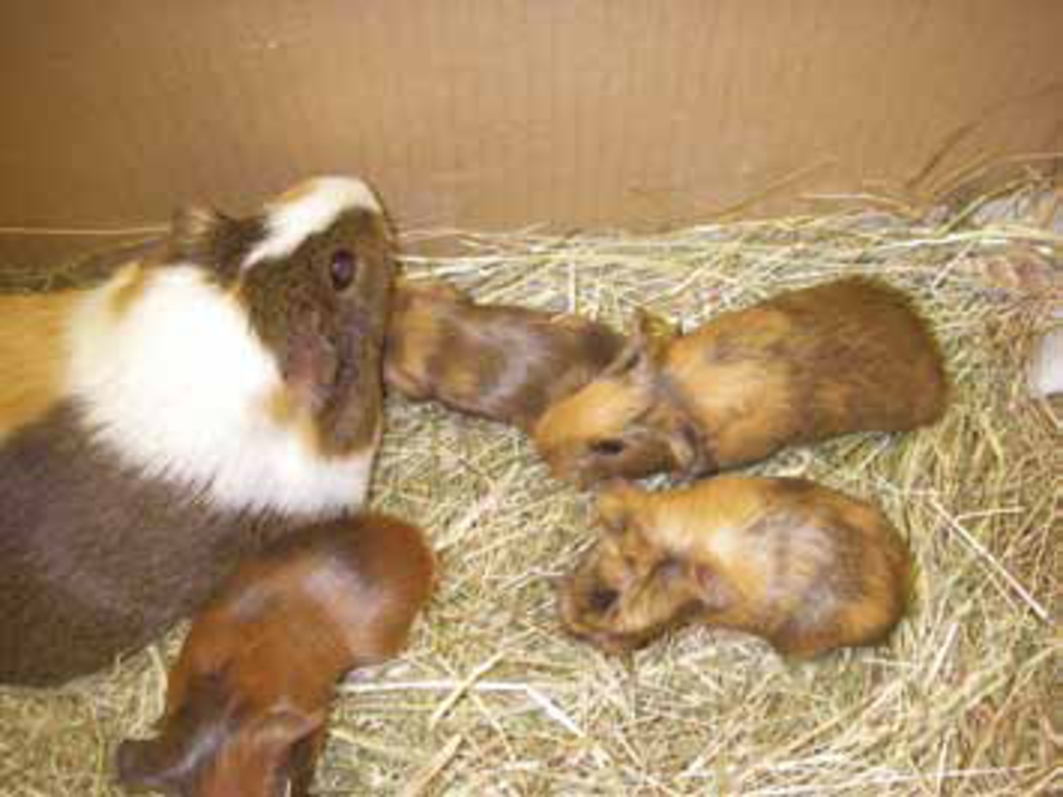
Anatomy and physiology
An understanding of the guinea pig digestive system is useful when advising on the correct diet for them, and also for problem solving any conditions that may be diet related.
The teeth
The guinea pig has two upper and two lower incisors for gnawing, which grow continuously throughout its life. These teeth only have enamel on their front surfaces and are therefore self-sharpening. It is very important to provide hard foods such as carrots for gnawing to maintain an even wear on the incisors. Wooden blocks and toys can also be supplied.
There are no canines; in their place is a gap known as the diastema. This is a useful place to introduce a syringe for dosing, or for syringe feeding anorexic patients.
There are four upper and lower cheek teeth on both sides (one premolar and three molars). The teeth are open rooted and grow continuously (hypsodontic) and so the guinea pig needs a constant supply of hard and fibrous food to ensure even wear of these teeth.
The digestive system
The guinea pig has a very long colon, which accounts for 60% of the length of its intestines, and it also has a large caecum for the digestion of cellulose. The caecum has a thin wall with numerous lateral pouches, and at any one time can hold up to 65% of the digestive contents (Richardson, 2000). The normal gastrointestinal flora is made up of gram-positive anaerobic cocci and lactobacilli. Gram-negative Escherichia coli and Clostridia are absent or present only in very low numbers. This means that it is very important to give a probiotic in any situation where the gut flora may become altered (such as the administration of oral antibiotics).
The liver
Guinea pigs often have a lot of fat cells in the liver and are very prone to the development of fatty liver and ketosis. If the guinea pig does not receive enough calories in its diet it very quickly starts breaking down its own fat cells to produce energy in the form of ketones. Ketosis (also known as toxaemia) is rapidly fatal. Any guinea pig that has been anorexic for 12–24 hours should be treated as a genuine emergency.
Coprophagia (caecotrophy)
The eating of its own droppings is a normal part of the digestive process. The guinea pig selectively eats the moist droppings (caecotrophs) directly from the anus. These caecotrophs are formed by bacterial fermentation in the caecum, and contain important B-complex vitamins and volatile fatty acids. Young guinea pigs will also be seen eating their mother's droppings as a way of populating their guts with a balanced bacterial flora before weaning. If a guinea pig is unable to practice caecotrophy for a period of time (e.g. an old boar with anal impaction) vitamin and probiotic supplementation will be useful (personal experience).
Quirky habits
Guinea pigs are very fastidious and do not accommodate alterations easily. An adult guinea pig is unlikely to try a foodstuff it has never seen before (personal experience). For this reason it is important to introduce a broad range of food at an early age. Guinea pigs are also more likely to eat something new if they can copy another guinea pig eating it. This is an important consideration for orphaned guinea pigs; it is best to keep them with an adult, even a gentle boar can act as an eating role model. Similarly guinea pigs are unable to adapt readily to a change of water source (i.e. bowl to bottle or vice versa) and may suffer water deprivation until they make the adjustment (personal experience). Water bottles are generally preferable as they are more hygienic.
If a group of guinea pigs are kept together it is important to make sure that there are no food-bullies. If one dominant guinea pig monopolizes the food it is important to provide food in many different places in the hutch so that each guinea pig has access to a balanced diet.
The basic diet
Guinea pigs spend the majority of their waking hours eating and benefit from a variety of food stuff.
A balanced diet should include the following every day:
| Beetroot — turns the droppings pink |
| Broccoli |
| Brussel sprouts |
| Cabbage |
| Carrot — root and leaves |
| Celery |
| Cauliflower — flesh and outside leaves |
| Lettuce — in small amounts |
| Spinach |
| Swede |
| Watercress — feed as a treat, very rich in calcium and iron and can cause bladder stones |
| Avens — astringent |
| Bramble (blackberry) leaves — astringent |
| Clover — good source of protein, a tonic |
| Dandelion — diuretic, high in calcium |
| Groundsel — do not feed if orange fungus on leaves |
| Plantains — astringent and diuretic |
| Raspberry leaves — astringent, feed in last 1/3 of pregnancy for easier births |
| Shepherd's Purse — astringent |
| Milk Thistle — good liver tonic |
| Yarrow — diuretic, astringent and urinary antiseptic |
Astringent plants are useful for the treatment of diarrhoea. Diuretics increase the action of the kidneys and aid in the removal of fluid
Fruits such as apples, pears, grapes, strawberries, melon, kiwi and tomatoes will all be enjoyed but should only be given in small amounts as they all have a high sugar content. Apples are also very acidic and may predispose to the development of sores around the lips.
Wild plants are fantastic free foods which add variation to the diet (Figures 3, 4 and 5), and many have useful medicinal properties (see Table 2). They should be collected away from areas soiled by dogs, free from bird droppings, and not from an area where pesticides or weedkillers have been used. With the advent of unleaded fuel there is less concern about collection near roadways, and all plants can be washed before feeding.
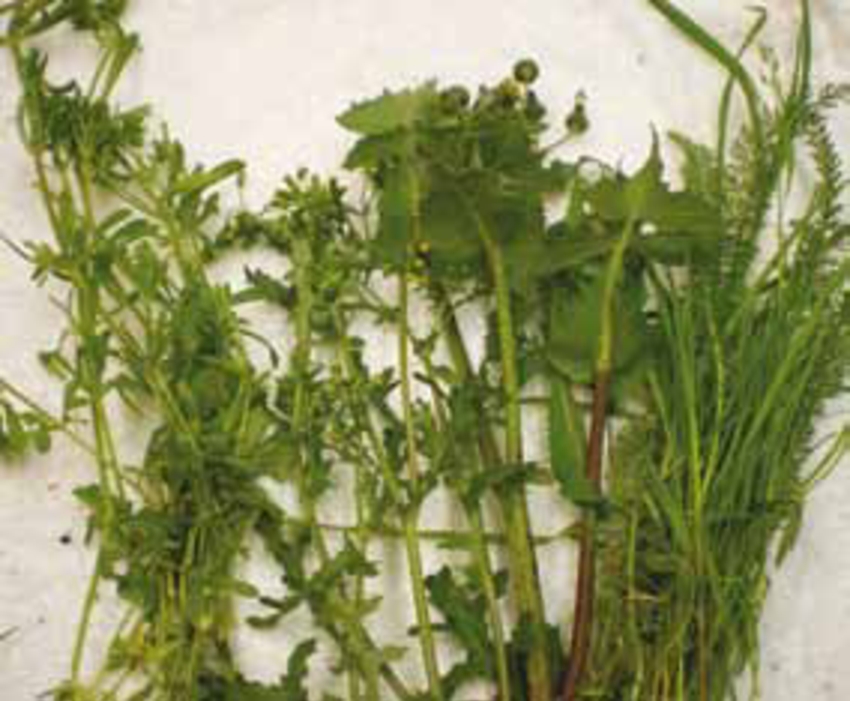
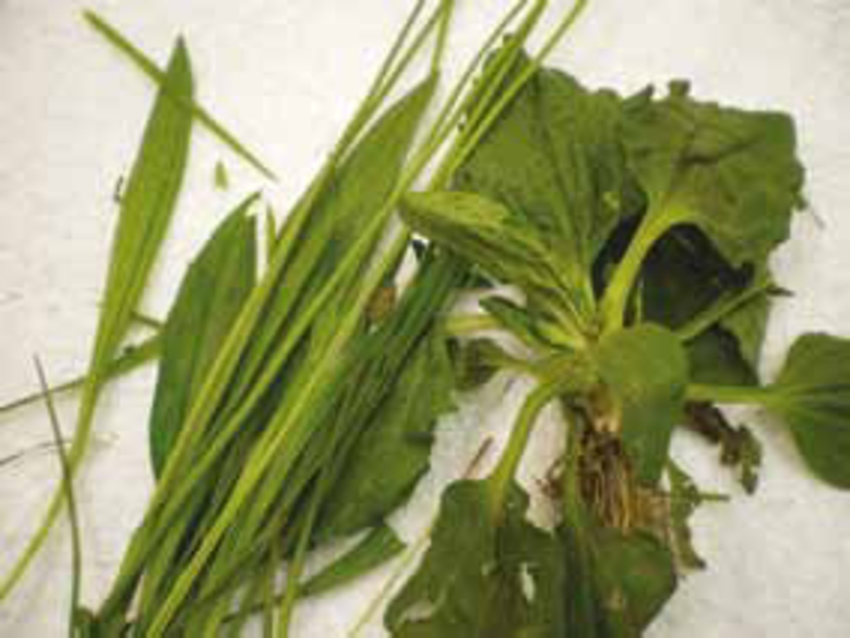
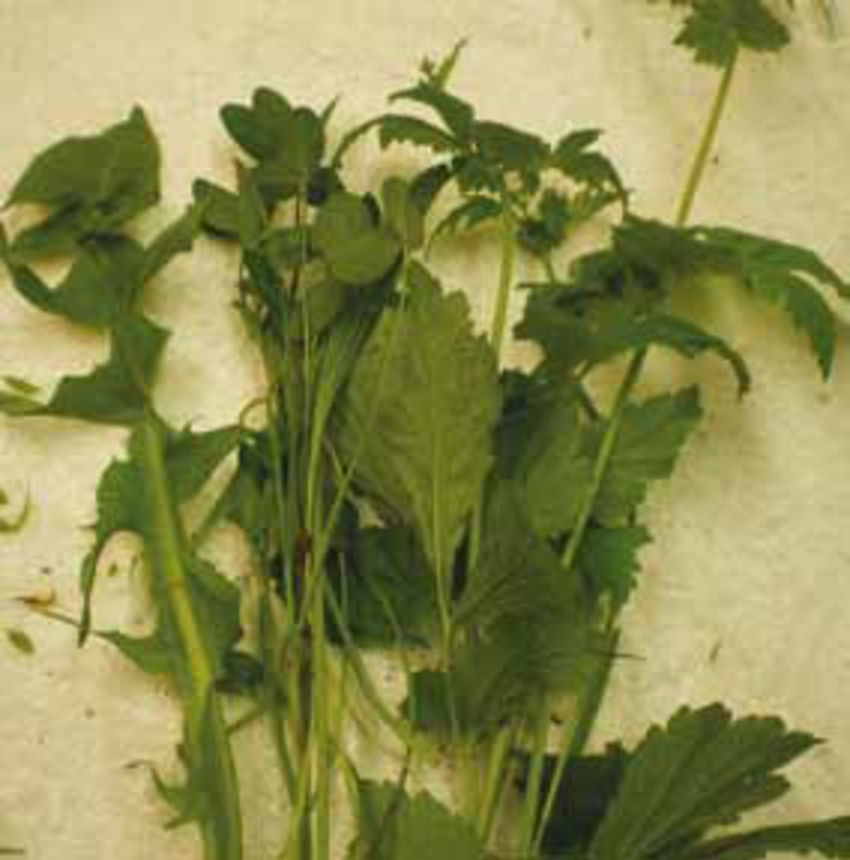
Vitamin C
The most important principle of guinea pig nutrition is their daily requirement for vitamin C. The guinea pig, like humans and apes, is unable to synthesize its own vitamin C (ascorbic acid) as it lacks the necessary enzyme to convert L-gulonolactone to L-ascorbic acid. The normal adult daily requirement is 10 mg/ kg, increasing to 20–30 mg/kg in illness or pregnancy (Richardson, 2000). The daily requirement should be met as long as a balanced diet of dry food, carrots and greens is fed. Many dry mixes now contain added vitamin C, although the actual content in the dry food may deteriorate with time and storage, so the manufacturer's use-by-date should be checked.
If deemed necessary vitamin C supplementation can be safely given in the drinking water. Hypervitaminosis C is not recognized as any vitamin C which is excess to requirements is excreted through the kidneys so that an overdose is not possible. The author recommends putting 1/10th soluble vitamin C tablet (equivalent to 100 mg) into a standard size 200 ml drinking bottle. Rosehip syrup is an excellent form of vitamin C which can also be put in the drinking water.
Important feeding principles
Any dietary change must be made slowly. This is particularly important when grass and wild plants become plentiful in the spring. Any sudden change will cause diarrhoea and digestive disturbances (Richardson, 2000). Many guinea pigs have outdoor runs allowing them to graze grass during the day. Their access time should be gradually built up in the spring when the grass is rich. They should never be put out on very wet or frosty grass because of the potential to cause digestive upsets.
All food should be fed fresh with no mould on it. Frosted food should not be fed as it will cause digestive upsets (Richardson, 2000). Similarly if fresh food is kept in the refrigerator it should be allowed to reach room temperature before it is fed. On cold nights any fresh food should be removed as it is likely to chill or freeze overnight.
As the guinea pig is always eating, a plentiful supply of hay is important. Good quality sun-dried hay will provide calcium and vitamin D, essential for strong bones and teeth (Cheeke, 2005). The presence of hay to eat will also prevent boredom and guinea pigs will be less likely to develop vices such as hair-chewing and hutch biting. Straw is not recommended as it has little nutritional value, and burrowing in straw leads to a high incidence of corneal ulceration (personal experience).
Common nutrition-related disease processes
Generally guinea pigs are hardy creatures, and with good husbandry and a balanced diet they are rarely ill. They get very few infectious diseases, and the majority of conditions seen in veterinary practice are usually related to some husbandry or nutritional issue. Never underestimate the significance of sub-clinical vitamin C deficiency. Even marginal vitamin C deficiency can be a predisposing factor in almost any disease state, and can be the pivotal factor in the recovery from illness or surgery (Richardson, 2000). A good knowledge of the correct nutrition will help solve and then correct many problems, and many conditions can be resolved with the strategic use of foodstuffs rather than reaching for some antibiotics (Richardson, 2000).
Scurvy (vitamin C deficiency)
Clinical signs of scurvy include general unthriftiness, gradual weight loss and wasting. Haemorrhages, which occurs around the stifle in cases of scurvy result in lameness and reluctance to move (Richardson, 2000). Haemorrhages around the temporomandibular joint, and weakening of the tooth ligaments may lead to secondary dental disease, reluctance to eat and salivation. Sub-clinical vitamin C deficiency will predispose the guinea pig to many conditions, particularly bacterial pneumonia, acute enteritis, and skin conditions (mange and ringworm) (Richardson, 2000).
Treatment consists of vitamin C given daily at a dose of 50–100 mg/kg (any excess is excreted by the kidneys and will not lead to overdose) (Richardson, 2000). Concurrent conditions must also be treated, and if the patient is anorexic it must be syringe fed to maintain a positive energy balance (more calories in than lost).
Diarrhoea
Although diarrhoea may be caused by Salmonella, Yersinia, Clostridia and E. coli, cases of these are uncommon, and digestive upsets are far more likely to be dietary in origin. Parasitic enteritis is rarely a problem in guinea pigs (Laber-Laird et al, 1996).
The guinea pig is unable to vomit, so that anything it eats has to pass through the digestive system. Most cases of diarrhoea result from sudden dietary change, or from the ingestion of poor quality or chilled foodstuffs (Richardson, 2000). Grass clippings (from the lawn mower) should never be fed, as they rapidly heat up and ferment causing diarrhoea (Richardson, 2000). See Table 3 for a list of poisonous plants.
| All plants that grow from bulbs | Henbane |
| Bracken | Horsetails |
| Bryony | Lily of the valley |
| Buttercup (but safe if dried in hay) | Monkshood |
| Charlock | Privet |
| Convolvulus (Bindweed) | Ragwort |
| Deadly Nightshade | Speedwell |
| Foxglove | Toadflax |
| Hellebore | Wild celery |
| Hemlock |
If the guinea pig is bright and alert most cases of non-specific diarrhoea can be treated by dietary modification (personal experience). The administration of a probiotic is helpful to restore the gut flora, and specific guinea pig probiotics are available (e.g. Avipro, Vetark, which has the benefit of added vitamin C) (personal experience)(Figure 6). Vitamin C is always useful. The dry food should be withheld, but plants with an astringent (binding action) should be given. Blackberry leaves are particularly valuable, as is Shepherd's purse, Yarrow and plantains (for those who are unable to obtain these, dried arrowroot and apple peel are useful) (Bell, 2007). Good quality hay should also be available and plenty of fresh water. The diarrhoea should resolve in 24–48 hours at which time the normal diet can be re-introduced slowly.
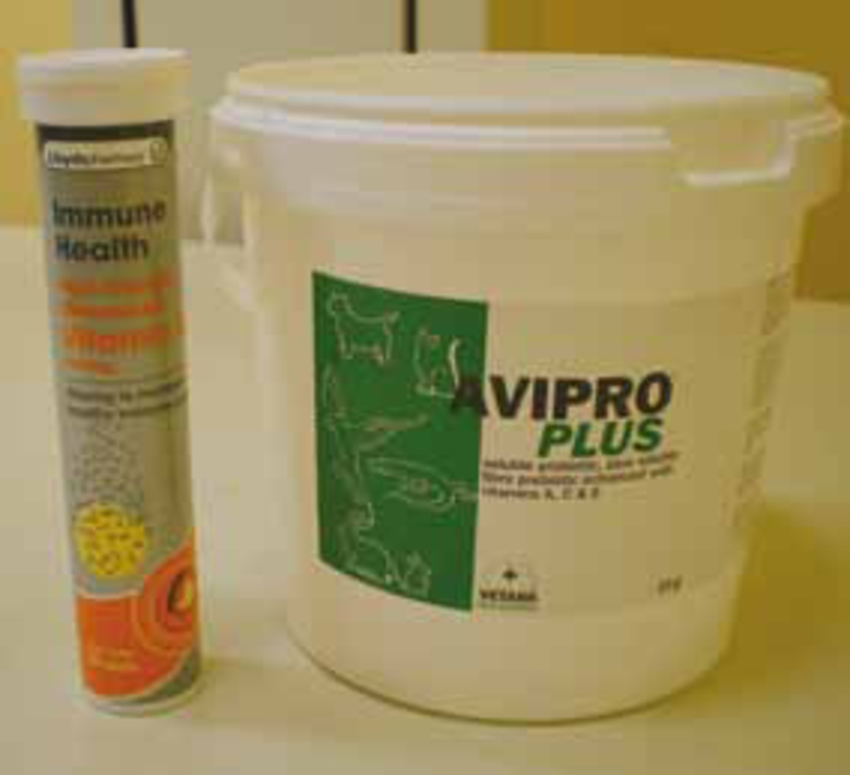
Colic and bloat
Colic and bloat may occur after the ingestion of fermented food, or an excess of brassica leaves (cabbage or kale). The guinea pig will have a swollen abdomen and be reluctant to move.
Treatment is by gentle massage of the abdomen; the guinea should be encouraged to move around. An infant preparation containing dimethecone (Infacol, Forest Laboratories UK Limited, Kent) 20–40 mg/kg can be given orally three times a day where there is excess gas (Girling, 2010).
Cystitis and bladder calculi
Cases of cystitis and bladder stones are becoming increasing common conditions seen in general practice (personal experience). There are likely to be some predisposing factors in the diet and lifestyle of affected guinea pigs. Clients may present their guinea pig for ‘constipation’ as they have seen their pet straining and squeaking. Due to the high fibre nature of the diet true constipation is never a problem, it is more likely their guinea pig is exhibiting dysuria (difficulty urinating). The other most common clinical sign is blood in the urine.
Dietary modification may help some cases of cystitis. As the calculi are predominately calcium, foodstuffs high in calcium should be avoided (Chinese cabbage, watercress, kale, dandelions, parsley and spinach). Cranberry juice could also be added to the drinking water as it is likely to increase fluid intake, and may have useful antibacterial properties. Yarrow is a urinary antiseptic.
Hepatic lipidosis
Hepatic lipidosis leads to ketosis, toxaemia and in pregnant sows, pregnancy toxaemia. Any obese guinea pig is at risk, as even a short period of anorexia (12 hours) may lead to the breakdown of body fat and the production of ketones (Laber-Laird et al, 1996).
Clinical signs include anorexia, lethargy, depression, a hunched and ruffled appearance. The classic ‘pear-drop’ smell of ketones will be present on the breath and salivation is common. Pregnant sows abort or have stillborn births.
Treatment is through achieving a positive energy balance by syringe feeding, and administration of a glucose solution. However once ketoacidosis has occurred the prognosis is guarded.
Prevention is the key, and nutritional advice is important here. Obesity should be prevented (especially during pregnancy) by providing plenty of hay and fresh food, but limiting the dry mix. Exercise should be encouraged by placing food at opposite ends of the pen. Feed regularly during the day to prevent periods of fasting which may trigger ketone production.
Nutritional support of the sick guinea pig
The most important principles:
Syringe feeding:
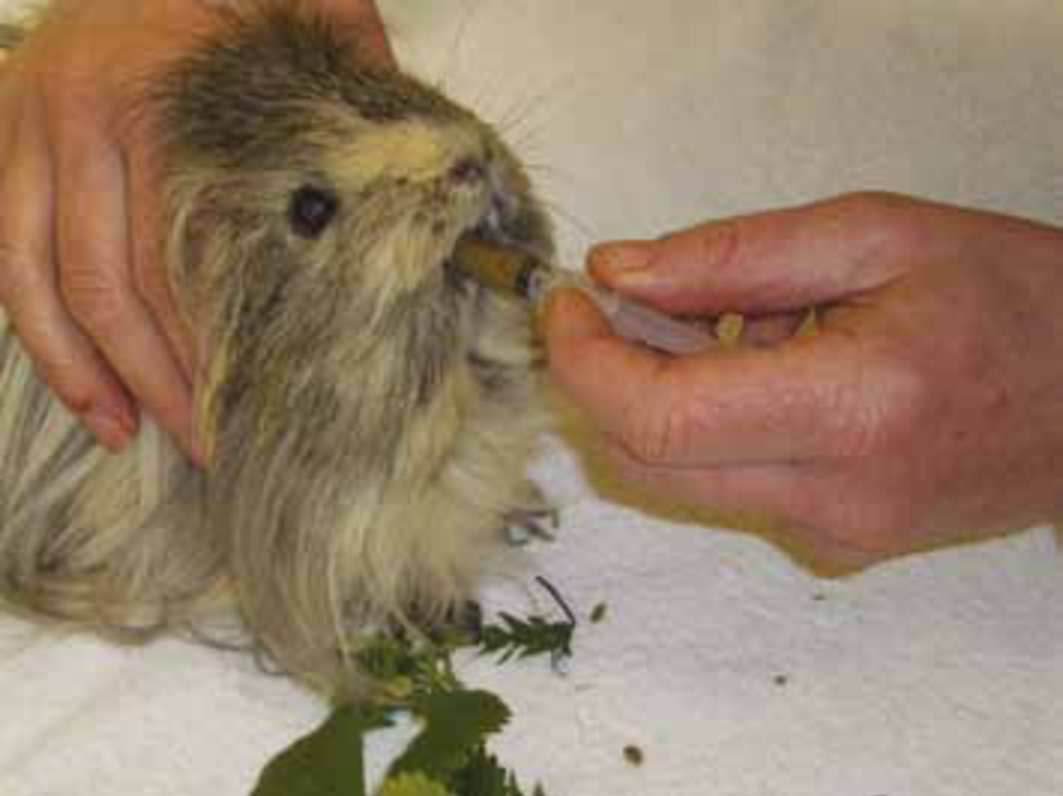
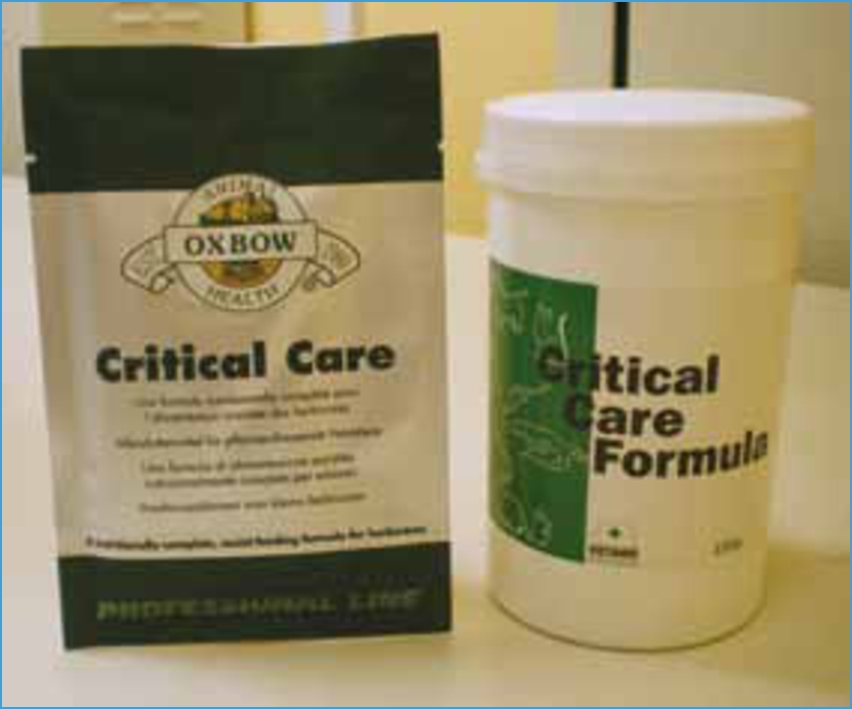
Conclusion
As nutrition is an underlying factor in many of the conditions seen in guinea pig patients in practice the more information obtained from the owner the better, as it will help solve the clinical problems, and knowledge of nutrition can be used to improve guinea pig health. As sub-clinical vitamin C deficiency is likely to be a predisposing factor for many conditions, and the value of vitamin C supplementation cannot be over stressed. When in doubt suggest it as overdoing the vitamin C never causes a problem and giving vitamin C can make all the difference to a guinea pig's recovery.
It is important to offer any anorexic guinea pig an appointment as soon as possible, as they rapidly develop ketoacidosis and can deteriorate very quickly.
